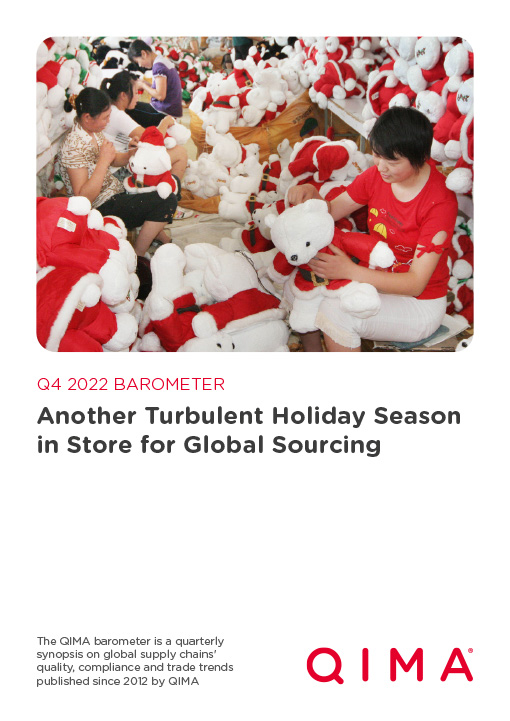QIMA 2022 Q4 Barometer
Q4 2022 Barometer: Another Turbulent Holiday Season in Store for Global Sourcing
Three quarters into 2022 and QIMA data shows that the global sourcing landscape remains in flux, with a deepening decoupling of global supply chains from China and intensified competition between other sourcing markets in Asia, while the specter of recession in the West chips away at consumer confidence and buying volumes.
These trends, combined with the continuing disruptions by China’s COVID-19 containment measures, natural disasters threatening key raw material regions and the ongoing geopolitical turmoil, suggest that global sourcing may be headed for another turbulent holiday season.
Inflation, Geopolitics and Lockdowns Combine to Keep Driving the Drift of Western Buyers from China
QIMA data on inspection and audit demand shows that throughout Q3 2022, interest in made-in-China sourcing among Western buyers continued shrinking at the same pace as during H1 2022. Inspection and audit demand from US- and EU-based buyers was down -5% YoY in Q3, reflecting the inflation-stifled consumer sentiment in the US and the EU, the continued decoupling of Western supply chains from China, and the ongoing disruptive effect of COVID-19 lockdowns, despite the earlier hopes that China's transition to a "dynamic zero-COVID" policy would lessen the burden of virus containment on manufacturing. The Electrical and Electronics sector remains among the most affected, between the continuing semiconductor shortage and the increased shifting of tech sourcing to China’s competitors, including Vietnam, Malaysia and more recently, India.
Nevertheless, when put in perspective, the Western buyers’ move away from China remains slow: while over two-thirds of QIMA’s 2022 survey respondents reported no increased buying from Chinese suppliers in 2022 compared to 2021, only 6% reduced their China sourcing significantly. In a similar juxtaposition illustrating the continued importance of China to Western supply chains, QIMA data on inspections and audits shows that China’s share among the top sourcing markets of Western buyers is at a four-year low – but almost 90% of the US- and EU-based survey respondents still name China as one of their TOP3 buying partners.
Fig. C1. Brand and retailers reported changes in China sourcing volumes in 2022 compared to 2021 (source: QIMA survey)

Fig. C2. US and EU buyer’s top sourcing markets by share (source: QIMA data)

Fig. C3. China inspection and audit YoY growth dynamic during 2022: selected industries (source: QIMA data)
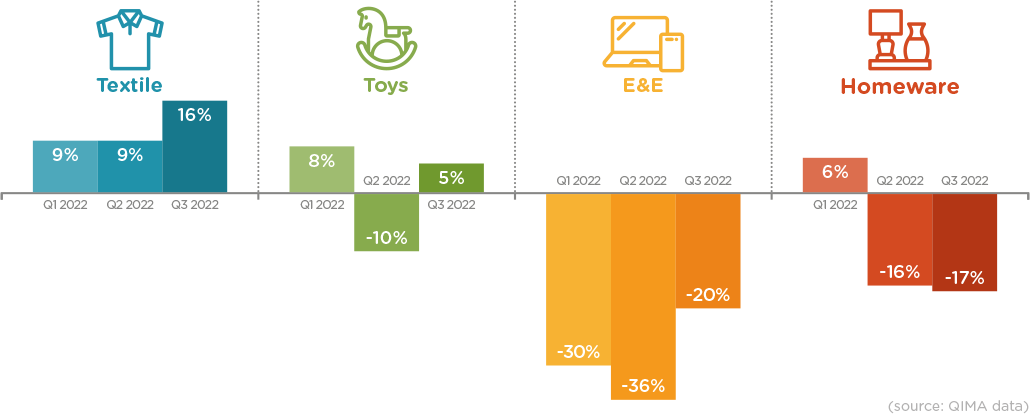
Vietnam Finally Back in the Game, Turning Tentative Rebound into Sustained Third-Quarter Growth
After seeing the first half of 2022 dampened by staff shortages and flagging demand, Vietnam appears to be winning back buyer confidence in H2 2022. Following the initial rebound in Vietnam’s manufacturing has successfully harnessed the momentum into continued growth throughout the third quarter, with demand for inspections and audits from US-based brands spiking +59% YoY in Q3, and more than doubling from EU brands. QIMA data shows that the influx of new business into Vietnam was especially pronounced in August, coinciding with another spate of lockdowns in China.
Fig. V1: YoY growth dynamic of Vietnam inspection and audit demand in 2022 (source: QIMA data)
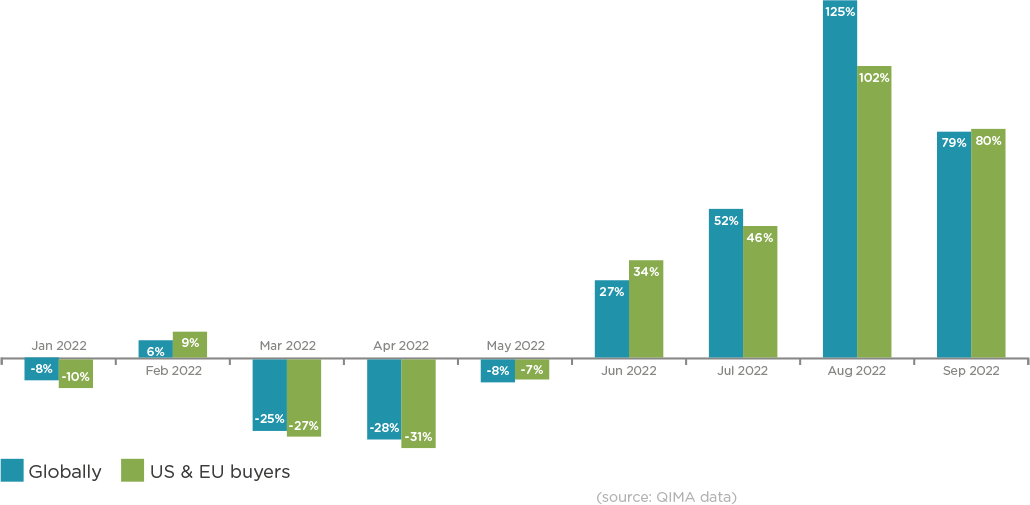
Other sourcing destinations in Southeast Asia have also entered H2 2022 on a strong footing, with QIMA data showing double-digit expansion in inspection and audit demand in Indonesia, Thailand and Malaysia, across multiple product categories. Malaysia in particular is being increasingly looked at for E&E sourcing as global tech brands shift manufacturing volumes from China.
India’s Growth Pace Stabilizes After a Period of Explosive Expansion
Following many consecutive quarters of explosive YoY expansion, India sourcing appears to be settling into a more sustainable growth pace, with demand for inspections and audits now up +13% YoY in 9M of 2022 (compared to +41% YoY growth in H1 2022). Some of this slowdown can be attributed to the high inflation in the EU and US weakening consumer demand for non-essentials, which includes apparel and especially homewares.
However, despite the importance of these product categories to India’s exports, India sourcing does not start and end with textiles: as seen from the increasing interest of major electronics brands, Apple and Google among them, in India’s manufacturing capacities. QIMA’s survey found that over a third of respondents working in the E&E sector expanded their sourcing footprint in India in 2022.
Other countries in the region are struggling with their own challenges, from the ongoing economic crisis in Sri Lanka to the devastating floods in Pakistan destroying almost half of the country’s cotton crops. These, combined with the slowdown in orders from the West, have all contributed to the comparatively modest +10% YoY expansion of inspection and demand in the South Asian region as a whole.
Fig. I1. Businesses that reported expanding their India sourcing in 2022 – by industry (QIMA survey)
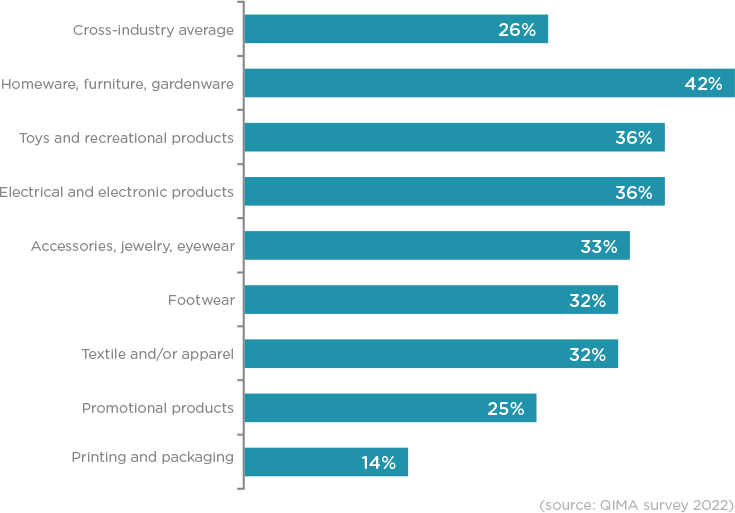
Near-Shoring Regions See Sustained Interest as Supporting Players
On the ongoing journey towards diversified sourcing, Western brands and retailers are still expanding their buying footprint in their respective near-shoring regions. In the Mediterranean, Turkey and Morocco respectively saw +26% YoY and +24% YoY growth in inspection and audit volumes from EU brands in 9M 2022; while across the Atlantic, Mexico and Guatemala both enjoyed double-digit expansion in inspection and audit demand from US-based buyers during the same time period. While this trend confirms their role as important components of supply chain diversification strategy, the volumes bought from near-shoring regions have a ways to go before they can reach the scale of overseas sourcing.
Critical Violations in Supply Chain Ethics Exceed Pre-Pandemic Levels
The data collected by QIMA ethical auditors during field audits in 2022 shows that ethical compliance in supply chains has yet to begin recovering from the sharp deterioration it saw with the onset of the pandemic. In four out of the five key domains assessed by QIMA auditors, the percentage of factories with critical violations in 2022 was notably above 2019 levels. Alarmingly, the likelihood of critical non-compliances related to child labor has almost doubled in 2022 compared to the pre-pandemic period.
With more than half of audited factories in need of immediate or near-term improvement for ethical compliance, there is a real need for brands and retailers to gain more visibility into their supply chains and take concrete steps to address violations – especially with the extra impetus added by the new and upcoming due diligence legislation in the US and the EU.
Fig. E1. Evolution of factory rankings assigned by QIMA ethical auditors, 2017-2022 (source: QIMA audit results data)
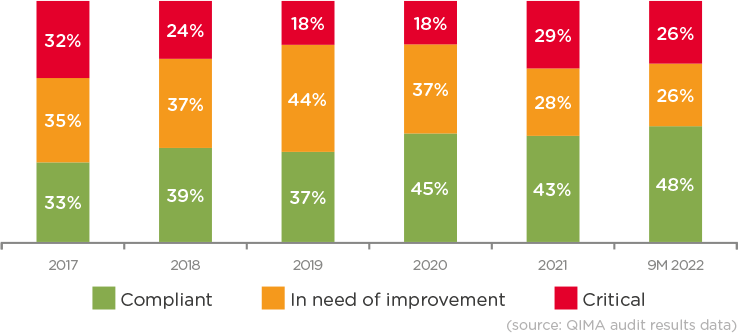
Fig. E2. Percentage of factories with critical non-compliances by category, 2019-2022 (source: QIMA audit results data)
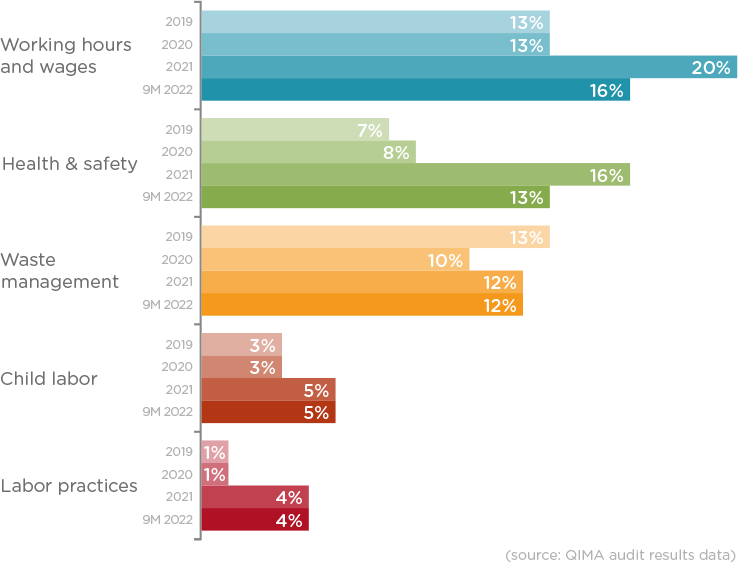
In the Current Volatile Sourcing Landscape, Supply Chains Flexibility Equals Resilience
The ever-increasing diversification of global supply chains suggests that brands and retailers are well underway to embracing uncertainty as the new norm of global sourcing. As a variety of supply chain disruptions continues rocking the global sourcing landscape, businesses that prioritize flexibility and adaptability in their supply chain strategy will be the best positioned to navigate the turbulence.
Press Contact
Email: press@qima.com
